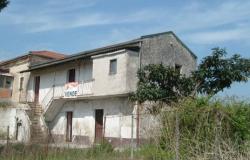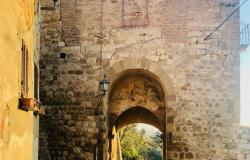Ancient golden and ochre houses climb up a gentle slope towards a hilltop crowned by a medieval tower. All around them, the undulating countryside is a mosaic of greens—the pale celadon of white poplars, the emerald of alders, the leathery green of holm oaks, the intense myrtle of vineyards, the silver of olive trees. And no, it is not Chianti.
It is Sabina, a verdant corner of Lazio, north of Rome—and it has little to envy to Tuscany. Dotted with monasteries, castles and deep gorges, Sabina’s sinuous, gentle hills have been a bucolic idyll since Roman times. Legend has it that the earlist Romans—descendants of Aeneas of Troy— had no women to call their wives, so they stole the girls of Sabina. When the Sabinian men went to rescue their sisters and daughters, the women, who had already grown attached to their Roman husbands, threw themselves between the two warring parties, and helped secure peace.
Whether this is true or not, the Romans soon came to appreciate the verdant landscape and thriving agriculture of the rich, lush Bassa Sabina—especially the fruity olive oil, which was made here since time immemorial. Galen, a Roman physician of Greek origin, sung its praises as a medicine, but the Sabinian oil was used for virtually everything from food to lamps, and even as a polisher for statues. Today, olive oil remains one of the cornerstones of Sabina’s cuisine—there is a giant olive tree in Canneto di Fara which is at least 1,500 years old—together with salty, slightly hot pecorino cheese, velvety mushrooms and golden honey. Even that quintessential Roman dish, spaghetti all’amatriciana (spaghetti with chilli, tomatoes, cured pork cheek and pecorino) actually comes from the village of Amatrice, on the Sabinian hills.
Although the lower Sabina is only about an hour away from Rome, this is Italy at its slowest and most genuine. It is also affordable. While the impossibly pretty villages of Casperia, Montasola or Bocchignano are prime second home country for today’s Romans, as well as those of the past, Sabina remains relatively unknown outside Italy—especially when compared with Chianti and other areas of Tuscany and Umbria. This ensures that property prices are still within the realm of reasonable.
“Sabina has two crucial advantages—it is little known (and thus you can still buy at moderate prices and the landscape is virtually pristine) and it is very close and well connected with the Italian capital—by car with the A1 motorway from Rome to Florence, and by train with the FM1 line from Orte to Fiumicino airport,” says Riccardo Tonnina of local estate agents Immobiliare Polidori.
It also helps that many houses here are full of Italian rustic charm. “The vernacular style is brick and stone—or stone alone for the more sophisticated homes—with wood and tile roofs and cotto floors,” says Tonnina.
Traditional stone casali are highly sought after but, says Tonnina, “they are increasingly harder to find.” However, old village houses in historic borghi have just as much character and are far more available and affordable. “Old village houses have mostly kept their characteristics intact,” Tonnina says, adding that “lately, there have ben a number of new builds in vernacular style—they may not have the same charm as restored period homes, but they are more comfortable (thanks to improved building standards and greater energy efficiency).”
Prices vary enormously, depending on property type and size, acreage and communication links with Rome. On average, however, buyers can expect to pay between €1,500 and €2,500 per square metre for renovated homes and €800 and €1,500 for those in need of restoration. “Prices in the area are more moderate when compared to other areas close to Rome,” says Tonnina. “And they are definitely lower than in Umbria and Tuscany.”
To visit in Sabina
Abbazia di Farfa: a grand medieval abbey with Baroque touches. The ancient herbalist shop sells olive oil, chocolate, tisanes, wine, honey and jam. Several events, from an antique fair to an olive oil festival take place on the abbey’s grounds throughout the year.
Chiesa di Santa Maria in Vescovio: a 12th century sanctuary with magnificent 14th century frescoes.
Riserva Naturale Regionale Nazzano Tevere Farfa: a wooded paradise covered with poplars, elders, purple willows, and riverside reeds. Great for birdwatching, it can be toured on foot, on horseback or by boat. Special night-time treks are also available.
Villages: Sabina is peppered with ancient, unspoilt villages. Virtually every one of them is a gem, but try not to miss Casperia, Montebuono, Tarano, Bocchignano (a hamlet near Montopoli), Montasola, Rocchette and Cottanello.
For sale in Sabina
Ancient palazzo in Rocchette
 For €250,000 you can buy a whole building in the medieval village of Rocchette. Set across three levels, this restored three-bedroom palazzetto has a rustic feel, heightened by such details as a fireplace, exposed beams and cotto floors. It has a large terrace with traditional oven and panoramic views over the castle at Rocchettino, a neighbouring hamlet.
For €250,000 you can buy a whole building in the medieval village of Rocchette. Set across three levels, this restored three-bedroom palazzetto has a rustic feel, heightened by such details as a fireplace, exposed beams and cotto floors. It has a large terrace with traditional oven and panoramic views over the castle at Rocchettino, a neighbouring hamlet.
Traditional-style villa near Poggio Catino
 A façade which is part whitewashed and part exposed stone sets the vernacular tone of this three-bedroom villa, which was built recently using traditional techniques and materials. Inside, exposed stone walls, beamed ceilings and a fireplace give the rooms a thoroughly Italian country charm. Set in a wood, the villa is private but not isolated. A terraced portico afford views over the village of Poggio Catino and the Soratte mountain. The asking price is €385,000.
A façade which is part whitewashed and part exposed stone sets the vernacular tone of this three-bedroom villa, which was built recently using traditional techniques and materials. Inside, exposed stone walls, beamed ceilings and a fireplace give the rooms a thoroughly Italian country charm. Set in a wood, the villa is private but not isolated. A terraced portico afford views over the village of Poggio Catino and the Soratte mountain. The asking price is €385,000.
Ancient casali to renovate near Cottanello
 The perfect buy for buyers looking for a restoration project, these three stone casali form a minuscule hamlet in the countryside near Cottanello. They are some 240 years old with original cotto floors and beamed roofs. The casali come with about 7,390 square metres of agricultural land, and would be ideal to set up a Bed & Breakfast operation. The asking price is €210,000.
The perfect buy for buyers looking for a restoration project, these three stone casali form a minuscule hamlet in the countryside near Cottanello. They are some 240 years old with original cotto floors and beamed roofs. The casali come with about 7,390 square metres of agricultural land, and would be ideal to set up a Bed & Breakfast operation. The asking price is €210,000.
All the properties are for sale through Polidori Immobiliare, www.immobiliarepolidori.it, +39 0765 576477.













